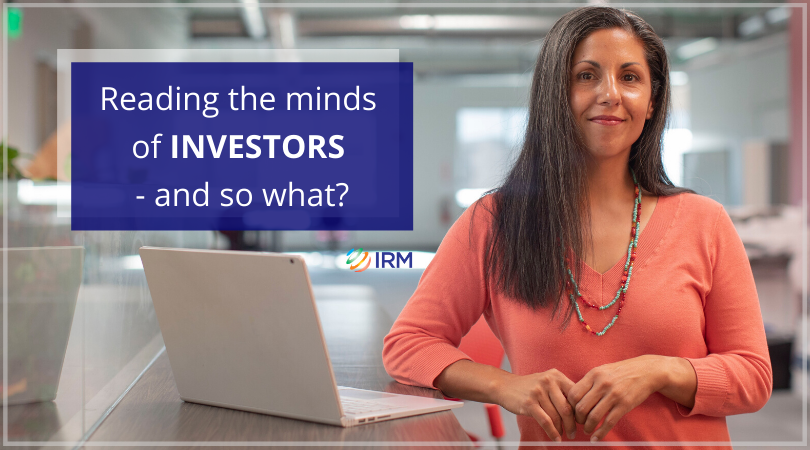In an earlier blog post, we identified investors as people -- they behave emotionally as well as rationally. We looked at ways to help them LIKE your company and SELL the first click.

Now, let's think more about the details of who your investors are. Who are these people you need to connect with, and what is in their mind?
Customer Journey = Investor Journey
In the consumer world, marketers understand the concept of a "customer journey," the stages consumers go through to buy a product. If we think about the stages of buying shoes, here's how it could look like:
I wear shoes > I need shoes > I want shoes now > I've bought new shoes> My shoes are worn out and I need more
Let's use this concept for investors and call it the "investor journey". You can read more about the investor journey here or download a white paper through this link.
So... selling shares is like selling shoes. When thinking about investors, think about various stages investors go through on their investor journey with you.
1. Existing shareholders
In your community of investors, a subset that’s very important is your existing shareholders. When you think about current shareholders in total, all they can do is sell.
Why? Because when they buy, they buy from each other. So in total (not individually), they are net sellers. All day, every day, 24/7 and globally, your current shareholders are selling your stock.
Obviously, you need to communicate well with current shareholders and keep them liking their investment in you. A happy group of current shareholders means fewer net sales and lowers the demand for new shareholders to replace them.
All the other places people can invest in are your competitors. Everybody else wants your existing shareholders to sell your stock and buy theirs. It's a tough world for listed companies.
 Investors go through various stages on their investor journey.
Investors go through various stages on their investor journey.
2. Today's buyers
Your existing shareholders are net sellers. When your shareholders decide to sell at a price, there needs to be a new person there to buy at that price.
Your job is to have a new person waiting there to buy the stock just as soon as it comes on the market. You need to find that new person - in competition with every other company that would prefer they bought their stock.
Who's going to buy shares from your existing shareholders? Today's buyers are the potential investors you've already "sold" on the idea, communicated with, spoken to and worked on. They like you, you fit their mandate, they have the cash, and the timing and price is right.
Today's buyers are just waiting for something to happen for them to buy - maybe its price, stock availability, or a piece of positive news. You need to look after them because their buying will protect or improve the price.
3. Tomorrow's buyers
There's another investor group further away from you. These people have heard of you, know you, thought about you. Maybe they’re interested. Maybe they’re not.
There needs to be some trigger to get them to decide that they will step up and buy. Or maybe the trigger will cause them to drift further away from you.
The trigger might be internal for them - cash availability, mandate, or just finding the time. Or it may be something about you, perhaps the price, some news, or a change in the impression they have about you.
Individually, you don't know of course. But in total, you can do some things that have the potential to appeal to this group as a whole.
You know who some of them are, but not all, and you don't understand very many of their individual triggers. You can reach some individually, but most need to be reached collectively. People are moving in and out of this group at rates and times we don't understand.
4. The potential
This is a much bigger group, the biggest group of all. People who've never heard of you but might have a capability to buy. They need to find you first, then become interested.
 Communicate well with current shareholders and keep them liking their investment in you.
Communicate well with current shareholders and keep them liking their investment in you.
5. Ex-shareholders
Another important group of people. Some will hate you of course, but even that might be temporary. The rest at least know you, and depending on the trigger that caused them to sell, they might be likely to buy back in. They are probably more likely to be the next buyer than a complete stranger.
The advantage you have when thinking about this group is that you know who they are and what their previous behaviour was. If you can relate well to them and keep in touch (if they accept that idea), then you might push them back to being a buyer.
6. Advisers
A group that goes alongside all the subsets. These are the journalists, commentators, financial planners and advisors, stockbrokers, consultants and people who have opinions as influencers. Even the friends around the BBQ at weekends. They may not themselves be investors, but they will provide information and triggers for investors.
Moving through the Investor Journey
As people move through the stage of the journey, what causes them to move is some trigger which changes their perception or position. It may be a trigger internal to them - in which case you need to be in their mind when that happens. Or it may be a trigger created by you - a piece of news, usually an ASX announcement.
It's an imperfect world, so helping people move through the investor journey is a percentage game. By doing more of the right things, a higher percentage of investors at one stage of their journey will move to the next. Delivering the triggers to as many different people as possible, as often as possible, increases the chances of improving the percentages.
Which is why some companies with worse results than others (but better communication and is more likeable) will have a better share price and better investor sentiment than others with great results but keep it all too secret.
 Potential investors, former shareholders and advisers are part of your investor community.
Potential investors, former shareholders and advisers are part of your investor community.
So what?
You need to have an ongoing investor communications platform - messages and online technology - that contains messages targeted at each of the groups of investors at various stages of their journey. Here are five things to action soon:
1. Make sure your online communications are sensitive to people at different stages of their journey.
Don't assume that any reader knows as much about your project as you do - or even as much as you'd like them to. Some will, but most won't or will need reminding. Use links to project pages on your website, or past ASX Announcements, as reminders, without building too much clutter, especially in your ASX Announcements. And don't use jargon that newbies won't understand.
2. When people show the slightest interest, try to embrace them.
Give people every opportunity to subscribe for email alerts on your website, from your ASX announcements, from your social media posts. That way you can get back to them when you have the news that might trigger their move to the next stage of the investor journey.
3. Try to drive people online to your corporate website.
Your corporate website is where you have a better chance of controlling the dialogue and providing that trigger to move along the journey. Use the phrase "click here, for more info" or "go here", and so on.
4. Make sure the home page of your website is really easy to "like".
Your website should also provide the key info needed by people at all stages of the investor journey.
5. Investors don't wake up in the morning and rush to your corporate website.
But they're online somewhere. We call those places "Online Touchpoints". More about this in the next post of this series.
In conclusion
Investors are people who behave emotionally as well as rationally. They go through various stages on their investor journey with you. Make sure you have an ongoing investor communications platform to connect with them wherever they are on their journey to help them move from one stage to the next.
Read this series' next blog post on the "Stages of the Investor Journey - and so what?" here.
A nudge in the right direction
Need a bit of help with your online IR? We're just a call away.
As online investor communications specialists, IRM understands how you can best support investors in their journey. We help around 170 clients with their online investor touchpoints – websites, news, social media, reports and online tools.
Let's chat over at +61 2 8705 5444 or clientrelations@irmau.com to discuss your queries.
Btw, this blog post is part of the "5 New Ideas for Better Online Engagement with Investors" series. Catch up on the previous related blog post here: Who are these people we call investors - and so what?

 Online Investor Engagement Specialists
Online Investor Engagement Specialists



